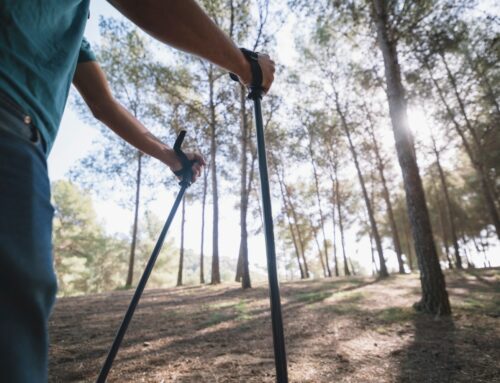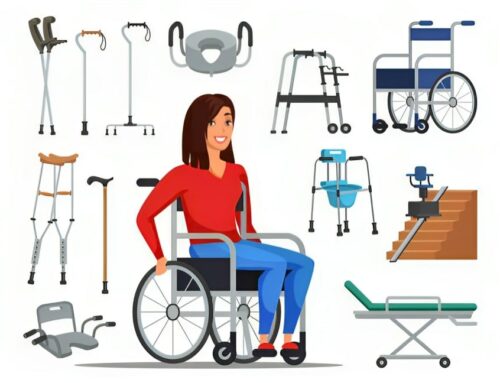While a wheelchair is ideal for people who have difficulty walking or standing, many people fall into that category of being able to walk but only with support. If you’re a little unsteady on your feet or get fatigued when walking long distances, a walking frame or aid like crutches allows you to maintain your independence while giving you the support you need.
Whether someone is experiencing temporary impairment as a result of injury or a longer-term disability that has decreased mobility, walking aids can make it easier to carry out daily tasks and take part in social activities.
There are a few things to consider when choosing a walking frame or aid. In this guide, we’ve outlined the different types of walking aids and the benefits of each, along with information on how to choose the right walking aid for you.
Types of walking aids
There are many different types of walking aids with each one designed to assist with a broad range of mobility issues and overall concerns. The different types of walking aids include walking sticks and canes, crutches, rollators and walking frames.
Below you’ll find information on the different types of walking aids.
Walking sticks and canes
Walking sticks and canes are the simplest type of mobility aid, offering a low level of support. They are designed for independent walkers who need a bit of extra confidence to tackle steps and uneven surfaces.
These are usually made of a lightweight aluminium, making them easy to carry and use. Walking sticks usually feature a moulded hand grip for comfort, along with a rubber tip for additional support.
Walking canes are available in a range of styles, include a simple straight walking stick or a curved neck design. The options also include a four-footed walking stick that provides increased stability and weight distribution.
Crutches
One of the most common types of walking aids, crutches are designed to provide stability and remove weight bearing from the legs. They are suitable for both short-term and long-term use by people who cannot place the full weight of their body on one or both legs.
Crutches are usually made from lightweight aluminium, although wood is sometimes also used, particularly when needed only for a short amount of time.
Underarm crutches are used as a pair and are placed under the arms to support the full body. These are typically used while recovering from knee or ankle surgery, or to recover after an injury.
Forearm crutches may be used in pairs or individually to provide additional stability. As they tend to cater to a greater variety of walking styles, they are usually given to younger patients or for long-term use. The style of forearm crutches distributes weight more evenly across the upper body and forearms, and avoids the rubbing that can come from underarm crutches.
Both styles of crutches require decent upper body strength and good coordination.
Rollators
A rollator is a type of walking frame that features wheels and a braking system. Because of its wheels, it is very manoeuvrable and is best for people who are able to walk but need help with balance and stability. Unlike a traditional walking frame, a rollator does not need to be lifted to move forward, which can help to conserve energy.
Rollators come in three-wheel and four-wheel styles, with the front wheels (or wheel) being on a swivel castor to help with turning. They come in a range of styles to suit the user, with many featuring a padded seat for resting, or a basket to help with carrying items.
Because of their lightweight design and wheels, someone using a rollator needs less upper body strength and stability. However, it’s important that they still have the strength required to activate the brake and the confidence to control a rollator in motion.
Walking frames
Walking frames offer sturdy, reliable stability for people who have difficulty walking. A standard walking frame features a simple, lightweight frame with four legs to provide support on flat surfaces.
To use a walking frame, you pick up the walker and move forward one step at a time. For this reason, the person using a walking frame must have enough arm strength to lift up the frame. This also can make it tiring to use for long periods or when navigating uneven surfaces.
Choosing the right walking aid
Walking aids offer increased freedom and independence for people who have difficulty standing and walking without assistance. Different types of walking aids offer varying levels of support and choosing the right walking aid comes your particular needs, ability and how you’ll use it.
Most walking aids are designed to provide stability for individuals who find it difficult or tiring to walk unaided. In situations where any kind of standing or walking is difficult, a walking aid may not be suitable, and it may be that the person is more suited to a wheelchair.
Walking aids can be used in conjunction with other mobility aids. You may choose to use a walking aid at home, and use a wheelchair when out and about, or vice versa.
A good place to start is chatting with your occupational therapist or doctor about what type of aid you might need. You can discuss your particular mobility needs, any limitations (such as arm or hand strength), and how you’ll use a walking aid to get around.
From there, you can try out a few options to see what you’re comfortable with. This might mean visiting a Mobility HQ store to test out different walking aids and get fitted properly.
Consider how and where you’ll use a walking aid
People use walking frames and aids for all sorts of reasons. It might be for just a short period while they recover from injury or surgery, for just a few hours a day to avoid becoming tired, or for regular, daily use due to an ongoing disability.
Before you choose a walking aid, think about how and where you plan to use it. If you want something for occasional use while out of the house, you might need only a walking stick or cane, which you can easily put to one side when you’re not using.
If you need something that helps with your posture and takes the strain off the legs and lower back, then a rollator may be suitable. A rollator is also a good option for use outdoors and on uneven terrain because the four wheels help to spread your weight and can easily be manoeuvred in small spaces.
Get it fitted to you
The best walking aid is one that has been specifically fitted to you. An ill-fitting walking aid can be less safe than not using one at all because it can cause you to be off-balance.
The height of the frame is important. Most walking frames and aids come with adjustable points for different heights, although if you’re particularly tall or short some styles may not be suitable. And remember to wear your regular footwear when getting measured for a walking aid.
When it comes to walking frames and rollators, the width should also be considered. If you’re going to be using it around the home, then you may want a slightly narrower frame to fit through doorways and around furniture. However, larger individuals may only get the right support with a wider frame.
Learn to use it properly
As with any mobility aid, it can take time and practice to use a walking aid safely. If you’re working with an occupational therapist, it’s they’ll help you develop the right technique to use your mobility aid safely. It’s important to build up your confidence by starting on flat surfaces over short distances. You can then practice using your walking aid in more difficult areas, such as going up and down stairs and ramps, or while carrying a bag or small items.
Reassess regularly
A person’s mobility needs can change over time and it’s important to regularly reassess whether you’re using the right walking aid. There are a few indications that a walking aid may no longer be suitable, including:
If you’re no longer able to walk as far with the walking aid
If you become tired after only a short amount of time
If you feel unsteady while using the walking aid
If you’re no longer doing activities they used to be able to
If your walking aid is causing pain or discomfort
If this happens, chat with your health care team about changing how you use your mobility aid, or even getting fitted for something else.
Using your walking aid safely
As we outlined above, your occupational therapist will be able to assist you with choosing a walking aid and helping you learn to use it safely. But there are a few things you can do to help keep you safe while using a walking aid.
Keep the floor clear – look out for loose carpet, rugs and clutter and make sure pathways are kept clear.
Avoid slippery areas – make sure any spills are cleaned up and that you’re using the right mobility aids in wet areas.
Wear the right shoes – you should wear functional, supportive and comfortable footwear.
Check for wear and tear – check your walking aid for signs of general wear, particularly on the slip-resistant feet, wheels and brakes. Also, look for cracks in the frame and any loose connections.
Walking aids and travel
Because walking frames and aids are so lightweight and mobile, they can travel with you everywhere you go so you’ll always have it to hand. Some walking aids can also be folded up for even easier transport and storage.
You’ll be able to take walking aids on public transport, but it may be more difficult if you’re catching an older style bus or tram with steep steps and a narrow doorway. In this case, see if your route offers accessible services. Sometimes the operator will add an accessible service if you request it in advance – so it doesn’t hurt to check.
If you’re travelling by plane, you can generally take a cane or crutches on board with you. The crew will get you seated and then stow your walking aid until you land. For safety, walking frames and rollators can’t be taken into the cabin unless they are foldable, in which case they can be stowed on board. Otherwise, your walking frame will be placed in the hold. If you’re not sure about whether you can take your mobility aid on board, it’s best to speak directly to your airline.







